Submit the following programs via Gradescope:
- Due Date: 1 February Think CS: Chapters 1 & 2
Write a program that prints "Hello, World!" to the screen.
Hint: See Lab 1.
- Due Date: 4 February Think CS: Chapter 4
Write a program that draws an octagon (8-sided polygon).
Note: Choose a name for your file that is not turtle.py. When executing the "import turtle" statement, the computer first looks in the folder where the file is saved for the turtle module and then in the libraries (and other places on the path). So, it thinks the module is itself, causing all kinds of errors. To avoid this, name your program something like "myTurtle.py" or "program2.py".Hint: See Lab 1.
- Due Date: 5 February Think CS: Chapter 4
Write a program that implements the pseudocode ("informal high-level description of the operating principle of a computer program or other algorithm") below:
Repeat 45 times: Walk forward 100 steps Turn right 92 degrees Walk forward 10 steps Turn right 92 degreesYour output should look similar to:

- Due Date: 6 February Think CS: Chapter 2 and
Section 4.7
Write a program that will print the Hunter College motto ("Mihi cura futuri" which translates to: "The care of the future is mine") 19 times.
The output of your program should be:
Mihi cura futuri Mihi cura futuri Mihi cura futuri Mihi cura futuri Mihi cura futuri Mihi cura futuri Mihi cura futuri Mihi cura futuri Mihi cura futuri Mihi cura futuri Mihi cura futuri Mihi cura futuri Mihi cura futuri Mihi cura futuri Mihi cura futuri Mihi cura futuri Mihi cura futuri Mihi cura futuri Mihi cura futuri
- Due Date: 7 February Think CS: Chapter 4
Copy the program from Section 4.3 into a file on your computer and modify the program (with turtles alex and tess) to have a purple background color and have tess draw white lines:
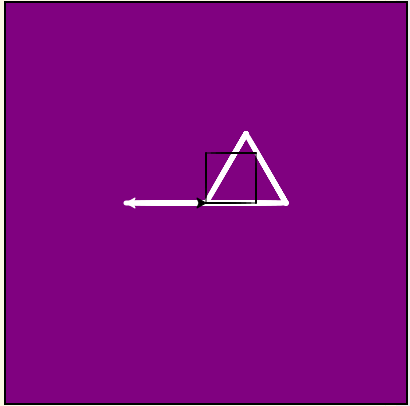
- Due Date: 8 February Think CS: Chapter 2 and
and
Section 4.7
Write a program that prints out the numbers from 0 to 14.
The output of your program should be:
0 1 2 3 4 5 6 7 8 9 10 11 12 13 14
Hint: Use a loop and print out the index or loop variable.
- Due Date: 11 February Think CS: Chapters 2 & 9
Using the string commands introduced in Lab 2, write a Python program that prompts the user for a message, and then prints the message, the message in upper case letters, and the message in lower case letters.
A sample run of your program should look like:
Enter a message: Mihi cura futuri Mihi cura futuri MIHI CURA FUTURI mihi cura futuri
Another run:
Enter a message: I love Python! I love Python! I LOVE PYTHON! i love python!
Hint: Your program should be able to take any phrase the user enters and prints it, it in upper case letters, and it in lower case letters. To do that, you need to store the phrase in a variable and print variations of the stored variable.
- Due Date: 13 February Think CS: Chapters 2 & 9
Write a program that prompts the user to enter a phrase and then prints out the ASCII code of each character in the phrase.
A sample run of your program should look like:
Enter a phrase: I love Python! In ASCII: 73 32 108 111 118 101 32 80 121 116 104 111 110 33
And another sample run:
Enter a phrase: ABC In ASCII: 65 66 67
Hint: If c is a character, ord(c) returns its ASCII code. For example, if c is 'I', then ord(c) returns 73. See Lab 2.
- Due Date: 14 February Think CS: Chapters 2 & 9
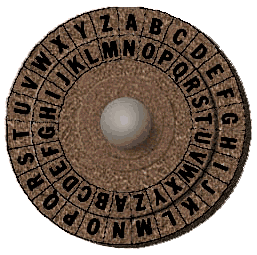
(The cipher disk above shifts 'A' to 'N', 'B' to 'O', ... 'Z' to 'M', or a shift of 13. From secretcodebreaker.com.)Write a program that prompts the user to enter a word and then prints out the word with each letter shifted right by 13. That is, 'a' becomes 'n', 'b' becomes 'o', ... 'y' becomes 'l', and 'z' becomes 'm'.
Assume that all inputted words are in lower case letters: 'a',...,'z'.
A sample run of your program should look like:
Enter a word: zebra Your word in code is: mroen
Hint: See the example programs from Lecture 2.
- Due Date: 15 February Think CS: Chapters 2 & 4
Write a program that implements the pseudocode below:
For i = 5, 10, 15, 20, 25, ... ,300: Walk forward i steps Turn left 91 degreesYour output should look similar to:
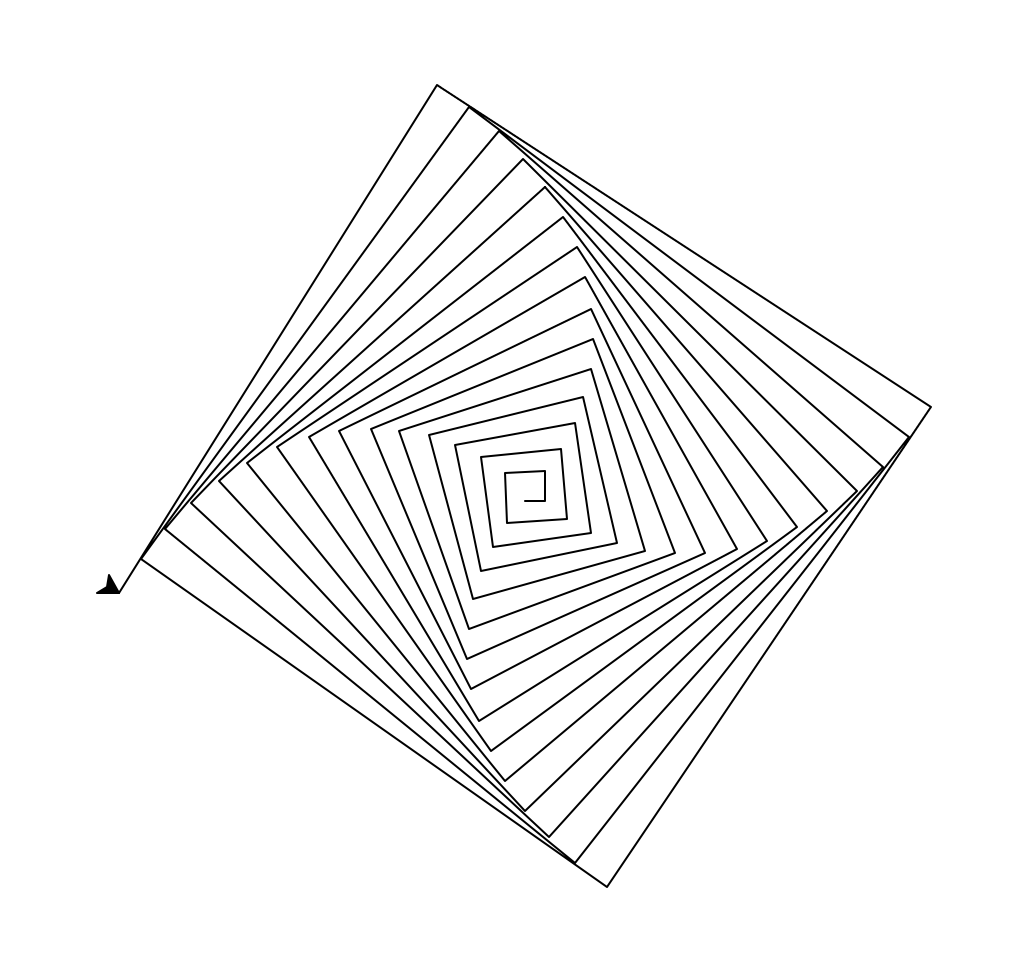
Hint: See examples of range(start,stop,step) in Lecture 2 notes.
- Due Date: 19 February Think CS: Chapters 2 &
9
Write a program that prompts the user for a DNA string, and then prints the length and GC-content (percent of the string that is C or G, written as a decimal).
A sample run of your program should look like:
Enter a DNA string: ACGCCCGGGATG Length is 12 GC-content is 0.75
And another sample run:
Enter a DNA string: AAAAA Length is 5 GC-content is 0.0
Hint: See Lab 2.
- Due Date: 20 February Think CS: Chapters 2 & 9
Write a program that asks the user for a message and then prints the message out, one character per line. Each line should also contain a '!!'.
A sample run of your program should look like:
Enter a message: I love Python! !! I !! !! l !! o !! v !! e !! !! P !! y !! t !! h !! o !! n !! !
And another sample run:
Enter a message: Hunter !! H !! u !! n !! t !! e !! r
Note: The print() command can take multiple inputs to print at the same time. For example, print('!!',c) will print two exclamation points followed by a space and the contents of variable c. For example, if
c is "I", then it would print: !! I. Hint: See Lab 2 or Lecture 2 notes.
- Due Date: 21 February Think CS: Chapters 2 & 9
Write a program that prints an opening statement and then asks the user for a number and prints that many stars, one per line.
For example:
The fault is in our stars... Please enter a number: 2 * *
Another sample run:
The fault is in our stars... Please enter a number: 5 * * * * *
- Due Date: 22 February Think CS: Chapter 2
Modify the program from Lab 3 to show the shades of green.
Your output should look similar to:
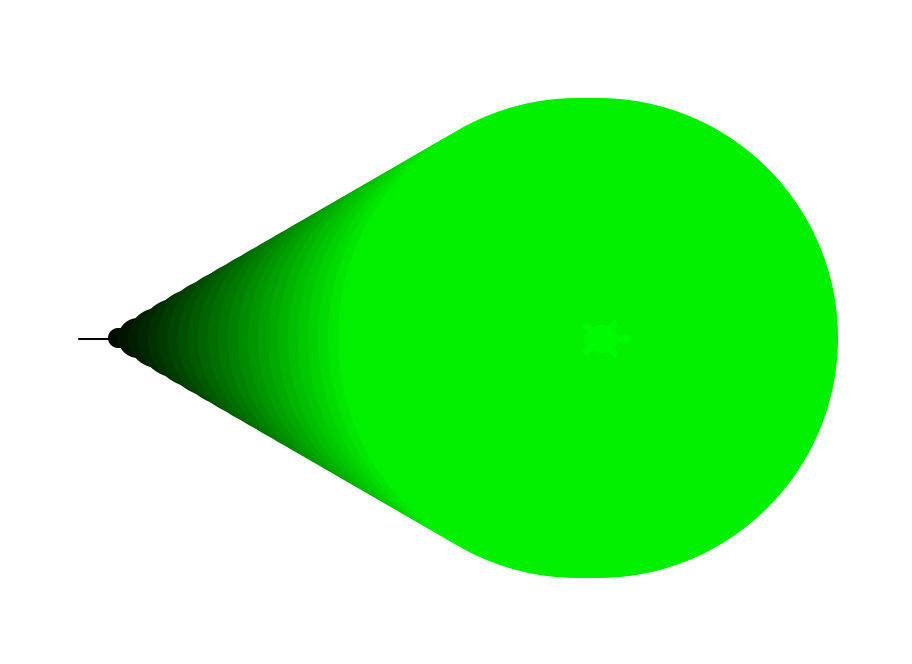
- Due Date: 25 February Think CS: Chapters 2 & 8.10 & Datacamp Numpy Tutorial
Write a program that asks the user for a name of an image .png file and the name of an output file. Your program should create a new image that has only the red and blue channel of the original image (that is, no green channel).
A sample run of your program should look like:
Enter name of the input file: csBridge.png Enter name of the output file: greenFreeH.png
Sample input and resulting output files:

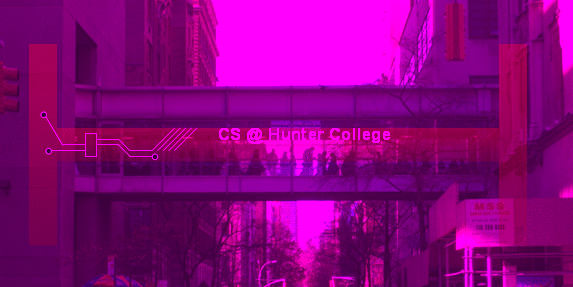
Note: before submitting your program for grading, remove the commands that show the image (i.e. the ones that pop up the graphics window with the image). The program is graded on a server on the cloud and does not have a graphics window, so, the plt.show() and plt.imshow() commands will give an error. Instead, the files your program produces are compared pixel-by-pixel to the answer to check for correctness.
Hint: See Lab 3.
- Due Date: 26 February Reading: Think CS: Chapter 4
Write a program that asks the user for 5 whole (integer) numbers. For each number, turn the turtle left the degrees entered and then the turtle should move forward 100.
A sample run of your program should look like:
Enter a number: 270 Enter a number: 100 Enter a number: 190 Enter a number: 200 Enter a number: 80
and the output should look similar to:
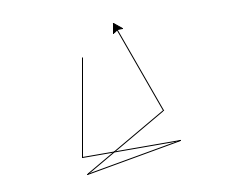
- Due Date: 27 February Reading: Think CS: Sections 2.7 &
Write a program that asks the user for a noun and two verbs (inspired by a Colgate University COSC 101 program). Using the words the user entered, print out a new sentence of the form:
If it VERB1 like a NOUN and VERB2 like a NOUN, it probably is a NOUN.
A sample run of the program:Enter a noun: duck Enter a verb: walks Enter another verb: talks New sentence: If it walks like a duck and talks like a duck, it probably is a duck.
Another sample run of the program:Enter a noun: cat Enter a verb: sounds Enter another verb: moves New sentence: If it sounds like a cat and moves like a cat, it probably is a cat.
Hint: Here's a way to approach the problem:
- Create a variable, template and store the string "If it VERB1 like a NOUN and VERB2 like a NOUN, it probably is a NOUN." in it.
- Ask the user for a noun and store it in a variable, noun.
- Replace the placeholder in the template with the noun the user entered (i.e. template = template.replace("NOUN", noun)).
- Ask the user for a noun and store it in a variable, verb1.
- Replace the placeholder in the template with the verb the user entered.
- Ask the user for another verb and store it in a variable, verb2.
- Replace the placeholder in the template with the second the verb the user entered.
- Print out the updated template string.
- Due Date: 28 February Think CS: Chapter 2 & Section 8.2
Create a program that creates a image of red and white stripes. Your program should ask the user for the size of your image, the name of the output file, and create a .png file of stripes. For example, if the user enters 10, your program should create a 10x10 image, alternating between red and white stripes.
A sample run of the program:
Enter the size: 13 Enter output file: stripes13.png

Another sample run of the program:
Enter the size: 50 Enter output file: stripes50.png

Note: before submitting your program for grading, remove the commands that show the image (i.e. the ones that pop up the graphics window with the image). The program is graded on a server on the cloud and does not have a graphics window, so, the plt.show() and plt.imshow() commands will give an error. Instead, the files your program produces are compared pixel-by-pixel to the answer to check for correctness.
Hint: See notes from Lecture 3.
- Due Date: 1 March Reading: Think CS: Section 2.7
Write a program that implements the pseudocode below:
1. Ask the user for the number of hours until the weekend. 2. Print out the days until the weekend (days = hours // 24) 3. Print out the leftover hours (leftover = hours % 24)
A sample run of your program should look like:
Enter number of hours: 27 Days: 1 Hours: 3
and another sample run:
Enter number of hours: 52 Days: 2 Hours: 4
Hint: See Section 2.7.
- Due Date: 4 March Reading: Think CS: Chapter 2
Write a program that converts kilometers to miles. Your program should prompt the user for the number of kilometers and then print out the number of miles.
A useful formula: miles = 0.621371* kilometers.
See Lab 4 for designing Input-Process-Output programs.
- Due Date: 5 March Think CS: Chapters 2 & 8.10 & Datacamp Numpy Tutorial
Modify the flood map of NYC from Lab 4 to color the region of the map with elevation greater than 6 feet and less than or equal 20 feet above sea level the color grey (50% red, 50% green, and 50% blue).
Your resulting map should look like:
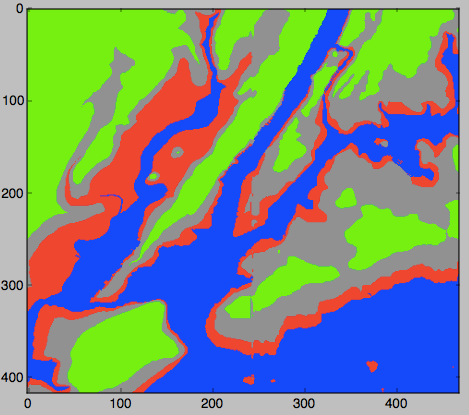
and be saved to a file called floodMap.png.
Note: before submitting your program for grading, remove the commands that show the image (i.e. the ones that pop up the graphics window with the image). The program is graded on a server on the cloud and does not have a graphics window, so, the plt.show() and plt.show() commands will give an error. Instead, the files your program produces are compared pixel-by-pixel to the answer to check for correctness.
- Due Date: 7 March Think CS: Chapter 7
The program turtleString.py takes a string as input and uses that string to control what the turtle draws on the screen (inspired by code.org's graph paper programming). Currently, the program processes the following commands:
- 'F': moves the turtle forward 50 steps
- 'L': turns the turtle 90 degrees to the left
- 'R': turns the turtle 90 degrees to the right
- '^': lifts the pen
- 'v': lowers the pen
Modify this program to allow the user also to specify with the following symbols:
- 'B': moves the turtle backwards 50 steps
- 'S': makes the turtle stamp
- 'l': turns the turle 45 degrees to the left
- 'r': turns the turtle 45 degrees to the right
- 'p': change the pen color to purple
Hint: See Lecture 4 notes.
- Due Date: 8 March Think CS: Chapters 7 & 8.10 & Datacamp Numpy Tutorial
Following Lab 5, write a program that asks the user for the name of a png file and print the number of pixels that are nearly white (the fraction of red, the fraction of green, and the fraction of blue are all above 0.75).
For example, if your file was of the snow pack in the Sierra Nevada mountains in California in February 2014:

then a sample run would be:
Enter file name: caDrought2014.png Snow count is 38010
Note: for this program, you only need to compute the snow count. Showing the image will confuse the grading script, since it's only expecting the snow count.
- Due Date: 11 March Reading: Burch's Logic & Circuits
Write a logical expression that is equivalent to the circuit that computes the majority of 3 inputs, called in1, in2, in3:
- If two or more of the inputs are True, then your expression should evaluate to True.
- Otherwise (two or more of the inputs are False), then your expression should evaluate to False.
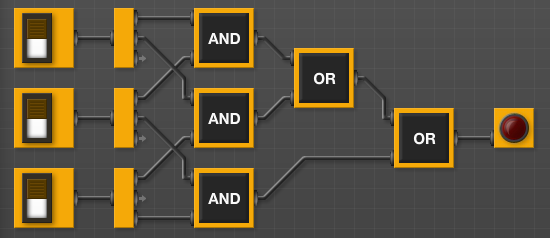
Save your expression to a text file. See Lab 5 for the format for submitting logical expressions to Gradescope.
- Due Date: 12 March Think CS: Chapters 7 & 8.10 & Datacamp Numpy Tutorial
Modify the map-mapking program from Lab 4 to create a map that outlines the coastline. Your program should create a new image, called coast.png with the pixels colored as follows:
- If the elevation is less than or equal to 0, color the pixel 50% blue (and 0% red and 0% green).
- If the elevation is exactly 1, color the pixel 75% red, 75% green, and 75% blue.
- Otherwise, the pixel should be colored 50% red, 50% green, and 50% blue.
Your resulting map should look like:
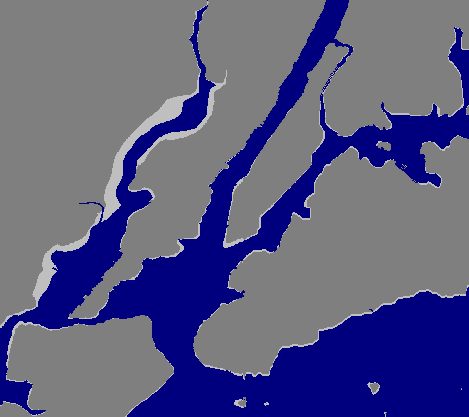
and be saved to a file called coast.png.
Note: before submitting your program for grading, remove the commands that show the image (i.e. the ones that pop up the graphics window with the image). The program is graded on a server on the cloud and does not have a graphics window, so, the plt.show() commands will give an error. Instead, the files your program produces are compared pixel-by-pixel to the answer to check for correctness.
- Due Date: 13 March Reading: Burch's Logic & Circuits
Build a circuit that has the same behavior as a nor gate (i.e. for the same inputs, gives identical output) using only and, or, and not gates.
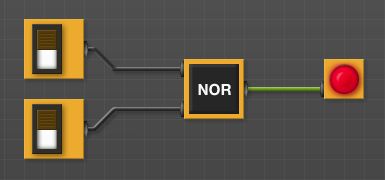
Save your expression to a text file. See Lab 5 for the format for submitting logical expressions to Gradescope.
- Due Date: 14 March Reading: 10-mins to Pandas, DataCamp Pandas
Modify the program from Lab 6 that displays the NYC historical population data. Your program should ask the user for the borough, an name for the output file, and then display the fraction of the population that has lived in that borough, over time.
A sample run of the program:
Enter borough name: Queens Enter output file name: qFraction.png
The file qFraction.png:
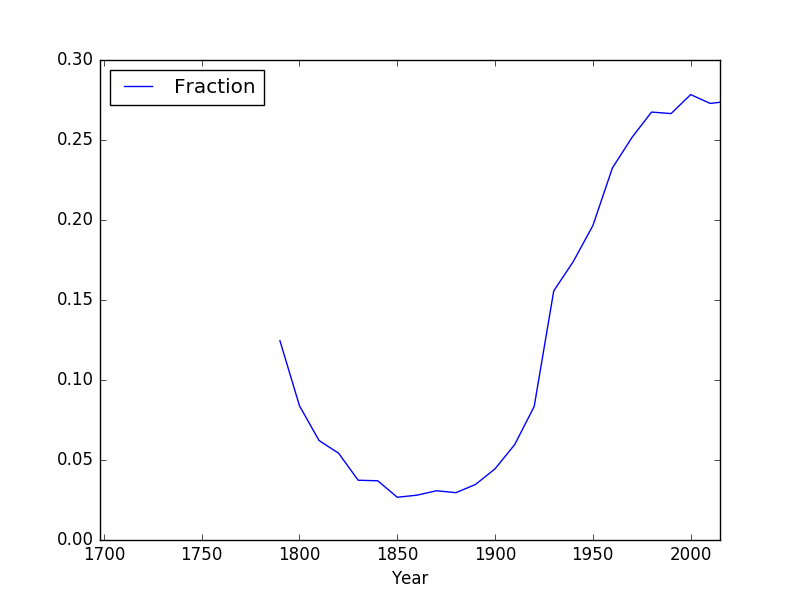
Note: before submitting your program for grading, remove the commands that show the image (i.e. the ones that pop up the graphics window with the image). The program is graded on a server on the cloud and does not have a graphics window, so, the plt.show() and plt.imshow() commands will give an error. Instead, the files your program produces are compared pixel-by-pixel to the answer to check for correctness.
- Due Date: 15 March Reading: 10-mins to Pandas, DataCamp Pandas
Write a program that computes the average and maximum population over time for a borough (entered by the user). Your program should assume that the NYC historical population data file, nycHistPop.csv is in the same directory.
A sample run of your program:
Enter borough: Staten Island Average population: 139814.23076923078 Maximum population: 474558
and another run:
Enter borough: Brooklyn Average population: 1252437.5384615385 Maximum population: 2738175
Hint: See Lab 6.
- Due Date: 18 March Reading: Ubuntu Terminal Reference Sheet
Write an Unix shell script that prints Hello, World to the screen.
Submit a single text file containing your shell commands. See Lab 6 for details.
- Due Date: 19 March Reading: Github Guide
In Lab 6, you created a github account. Submit a text file with the name of your account. The grading script is expecting a file with the format:
#Name: Your name #Date: April 2017 #Account name for my github account AccountNameGoesHere
Note: it takes a few minutes for a newly created github account to be visible. If you submit to gradescope and get a message that the account doesn't exist, wait a few minutes and try again.
- Due Date: 20 March Reading: Think CS: Section 7.4
Write a program that asks the user for the hour of the day (in 24 hour time), and prints
- "Good Morning" if it is strictly before 12,
- "Good Afternoon" if it is 12 or greater, but strictly before 17, and
- "Good Evening" otherwise.
A sample run:
Enter hour (in 24 hour time): 11 Good Morning
Another sample run:
Enter hour (in 24 hour time): 20 Good Evening
And another run:
Enter hour (in 24 hour time): 15 Good Afternoon
- Due Date: 21 March Reading: 10-mins to Pandas, DataCamp Pandas
Modify the program from Lab 7 that displays shelter population over time to:
- ask the user to specify the input file,
- ask the user to specify the output file,
- make a plot of the fraction of the total population that are children over time from the data in input file, and
- store the plot in the output file the user specified.
A sample run of the program:
Enter name of input file: DHS_2015_2016.csv Enter name of output file: dhsPlot.png
which produces an output:
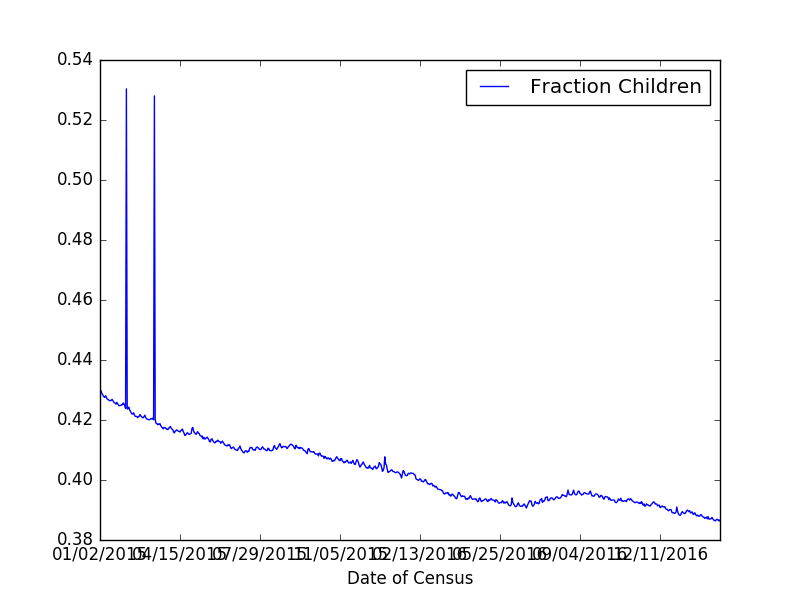
Note: The grading script is expecting that the label (i.e. name of your new column) is "Fraction Children".
- Due Date: 22 March Reading: Think CS Section 6.7
Write a program, using a function main() that prints "Hello, World!" to the screen. See Lab 7.
- Due Date: 25 March Reading: Burch's Logic & Circuits
Logical gates can be used to do arithmetic on binary numbers. For example, we can write a logical circuit whose output is one more than the inputted number. Our inputs are in1 and in2 and the outputs are stored in out1, out2, and out3.
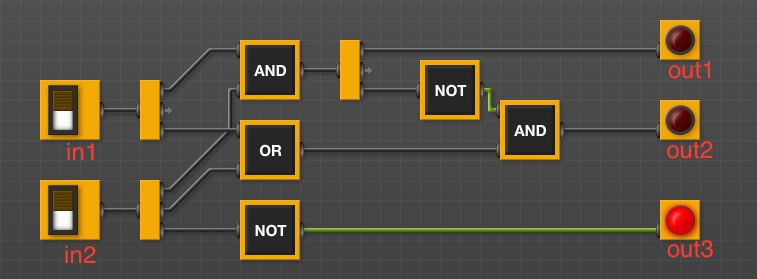
(click to launch new window with circuit)Here is a table of the inputs and outputs:
Inputs Outputs Decimal
Numberin1 in2 Decimal
Numberout1 out2 out3 0 0 0 1 0 0 1 1 0 1 2 0 1 0 2 1 0 3 0 1 1 3 1 1 4 1 0 0 Submit a text file with each of the outputs on a separate line:
#Name: YourNameHere #Date: April 2017 #Logical expressions for a 4-bit incrementer out1 = ... out2 = ... out3 = ...
Where "..." is replaced by your logical expression (see Lab 5).Note: here's a quick review of binary numbers.
- Due Date: 26 March Reading: Section 10.24
Write a program that prompts the user to enter a list of names. Each person's name is separated from the next by a semi-colon and a space ('; ') and the names are entered lastName, firstName (i.e. separated by ', '). Your program should then print out the names, one per line, with the first names first followed by the last names.
A sample run of your program should look like:
Please enter your list of names: Cohn, Mildred; Dolciani, Mary P.; Rees, Mina; Teitelbaum, Ruth; Yalow, Rosalyn You entered: Mildred Cohn Mary P. Dolciani Mina Rees Ruth Teitelbaum Rosalyn Yalow Thank you for using my name organizer!Hint: See Section 10.24 for a quick overview of split(). Do this problem in parts: first, split the list by person (what should the delimiter be?). Then, split each of person's name into first and last name (what should the delimiter be here?).
- Due Date: 27 March Reading: 10-mins to Pandas, DataCamp Pandas
Write a program that asks the user for the name of an image, the name of an output file. Your program should then save the upper right quarter of the image to the output file specified by the user.
A sample run of your program should look like:
Enter image file name: hunterLogo.png Enter output file: logoUR.png
which would have as input and output:
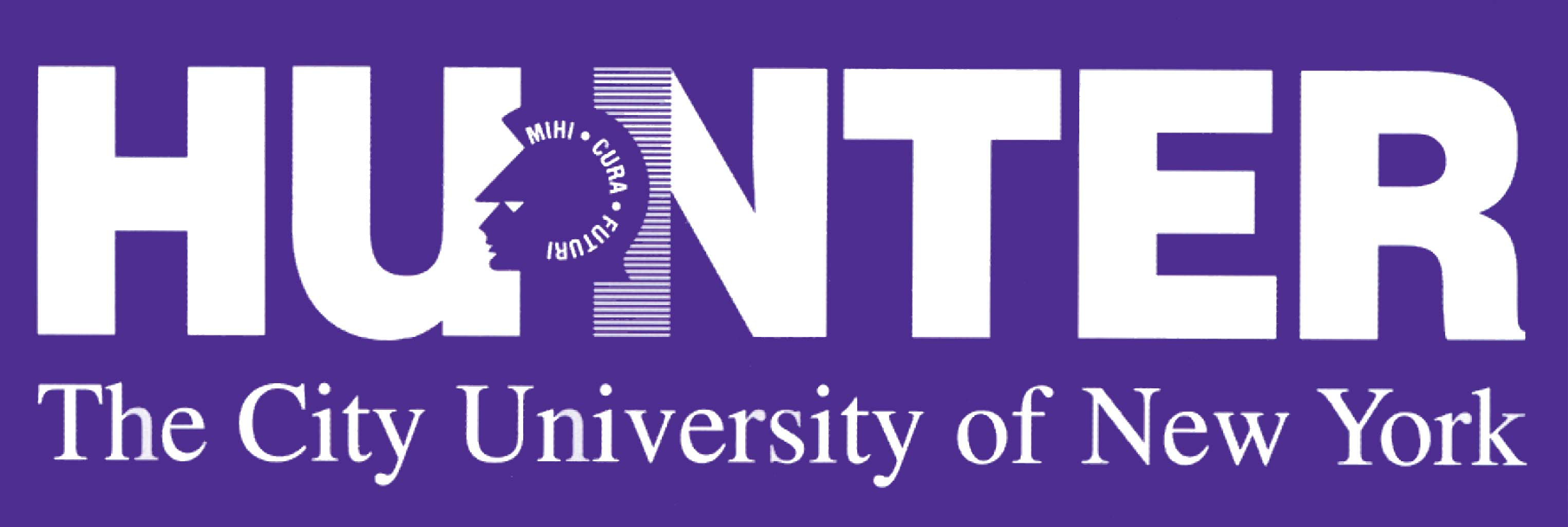

Hint: See sample programs from Lectures 3 and 6.
Note: before submitting your program for grading, remove any commands that show the image (i.e. the ones that pop up the graphics window with the image). The program is graded on a server on the cloud and does not have a graphics window, so, the plt.show() and plt.imshow() commands will give an error. Instead, the files your program produces are compared pixel-by-pixel to the answer to check for correctness.
- Due Date: 28 March Reading: 10-mins to Pandas, DataCamp Pandas
Modify the parking ticket program from Lab 8 to do the following:
- Ask the user for the name of the input file.
- Ask the user for the attribute (column header) to search by.
A sample run:
Enter file name: Parking_Violations_Jan_2016.csv Enter attribute: Vehicle Color The 10 worst offenders are: WHITE 2801 WH 2695 GY 1420 BK 1153 BLACK 1054 BROWN 727 BL 656 GREY 574 SILVE 450 BLUE 412 Name: Vehicle Color, dtype: int64
And another run:
Enter file name: Parking_Violations_Jan_2016.csv Enter attribute: Vehicle Year The 10 worst offenders are: 0 3927 2015 1265 2014 1143 2013 1105 2012 772 2011 666 2007 643 2008 559 2010 509 2006 499 Name: Vehicle Year, dtype: int64
- Due Date: 29 March Reading: Think CS: Chapter 6
Fill in the missing function, num2string(), in the program, numsConvert.py (available at: https://github.com/stjohn/csci127). The function should take number between 0 and 9 as a parameter and returns the corresponding number as a string. For example, if the parameter is 0, your function should return "zero". If the parameter is 1, your function should return out "one", etc.
Note: The grading scripts are expecting that your function is called num2string(). You need to use that name, since instead of running the entire program, the scripts are "unit testing" the function-- that is, calling that function, in isolation, with differrent inputs to verify that it performs correctly.
Hint: See notes from Lecture 7 and Lab 8.
- Due Date: 1 April Reading: 10-mins to Pandas, DataCamp Pandas
Write a program that asks the user for a CSV of collision data (see note below about obtaining reported collisions from NYC OpenData). Your program should then list the top three contributing factors for the primary vehichle of collisions ("CONTRIBUTING FACTOR VEHICLE 1") in the file.
A sample run:
Enter CSV file name: collisionsNewYears2016.csv Top three contributing factors for collisions: Driver Inattention/Distraction 136 Unspecified 119 Following Too Closely 37 Name: CONTRIBUTING FACTOR VEHICLE 1, dtype: int64
This assignment uses collision data collected and made publicly by New York City Open Data, and can be found at:
https://data.cityofnewyork.us/Public-Safety/NYPD-Motor-Vehicle-Collisions/h9gi-nx95.
Since the files are quite large, use the "Filter" option and choose your birthday in 2016 and "Export" (in CSV format) all collisions for that day. We will use this data set for future programs, so, instead of downloading the test files multiple times, save a copy for future use.Hint: See Lab 8 for accessing and analyzing structured data.
- Due Date: 2 April Reading: Think CS Chapter 6
Write two functions, triangle() and nestedTriangle(). Both functions take two parameters: a turtle and an edge length. The pseudocode for triangle() is:
triangle(t, length): 1. If length > 10: 2. Repeat 3 times: 3. Move t, the turtle, forward length steps. 4. Turn t left 120 degrees. 5. Call triangle with t and length/2.The pseudocode for nestedTriangle() is very similar:
nestedTriangle(t, length): 1. If length > 10: 2. Repeat 3 times: 3. Move t, the turtle, forward length steps. 4. Turn t left 120 degrees. 5. Call nestedTriangle with t and length/2.A template program, nestingTrianges.py, is available on the CSci 127 repo on github. The grading script does not run the whole program, but instead tests your function separately ('unit tests') to determine correctness. As such, the function names must match exactly (else, the scripts cannot find it). Make sure to use the function names from the github program (it is expecting triangle() and nestedTriangle()).
A sample run:
Enter edge length: 160
which would produce:

- Due Date: 3 April Reading: Think CS: Chapter 6
Write a function, computeFare(), that takes as two parameters: the zone and the ticket type, and returns the Long Island Railroad fare.
- If the zone is 1 and the ticket type is "peak", the fare is 8.75.
- If the zone is 1 and the ticket type is "off-peak", the fare is 6.25.
- If the zone is 2 or 3 and the ticket type is "peak", the fare is 10.25.
- If the zone is 2 or 3 and the ticket type is "off-peak", the fare is 7.50.
- If the zone is 4 and the ticket type is "peak", the fare is 12.00.
- If the zone is 4 and the ticket type is "off-peak", the fare is 8.75.
- If the zone is 5, 6, or 7 and the ticket type is "peak", the fare is 13.50.
- If the zone is 5, 6, or 7 and the ticket type is "off-peak", the fare is 9.75.
- If the zone is greater than 8, return a negative number (since your calculator does not handle inputs that high).
A template program, LIRRtransit.py, is available on the CSci 127 repo on github. The grading script does not run the whole program, but instead tests your function separately ('unit tests') to determine correctness. As such, the name of the function must match exactly (else, the scripts cannot find it).
A sample run:
Enter the number of zones: 4 Enter the ticket type (peak/off-peak): off-peak The fare is 8.75
And another:
Enter the number of zones: 6 Enter the ticket type (peak/off-peak): peak The fare is 13.5
Hint: See Lab 8.
- Due Date: 4 April Reading: Folium Tutorial
Write a program that uses folium to make a map of New York City. Your map should be centered at (40.75, -74.125) and include a marker for the main campus of Hunter College. The HTML file your program creates should be called: nycMap.html
Hint: See Lab 9.
- Due Date: 8 April Reading: Folium Tutorial
Using folium (see Lab 9), write a program that asks the user for the name of a CSV file, name of the output file, and creates a map with markers for all the traffic collisions from the input file.
A sample run:
Enter CSV file name: collisionsThHunterBday.csv Enter output file: thMap.html
which would produce the html file:
(The demo above is for March 18, 2016 using the time the collision occurred ("TIME") to label each marker and changed the underlying map with the option: tiles="Cartodb Positron" when creating the map.)
This assignment uses collision data collected and made publicly by New York City Open Data. See Programming Problem #39 for details on this data set. When creating datasets to test your program, you will need to filter for both date (to keep the files from being huge) and that there's a location entered. The former is explained above; to check the latter, add the additional filter condition of "LONGITUDE is not blank".
Hint: For this data set, the names of the columns are "LATITUDE" and "LONGITUDE" (unlike the previous map problem, where the data was stored with "Latitude" and "Longitude").
- Due Date: 9 April Reading: Think CS: Chapter 3
The program, errorsHex.py, has lots of errors. Fix the errors and submit the modified program.
Hint: See Lab 9.
- Due Date: 10 April Reading: Think CS: Chapter 6 and Folium Tutorial
Fill in the following functions in a program that maps GIS data from NYC OpenData CSV files and marks the current location and closest point:
- getData() that asks the user for the name of the CSV and returns a dataframe of the contents.
- getColumnNames() that asks the user for the exact name of the columns that contains the latitude and longitude and returns those values as a tuple. Since the NYC OpenData files use different names for the columns in different datasets (such as "Lat", "Latitude", "LATITUDE" for latitude), the program asks for the name of the column as well as the name of the data file.
- getLocale() asks the user for latitude and longitude of the user's current location and returns those floating points numbers.
- computeDist() that computes the squared distance
between two points (x1,y1) and (x2,y2):
(x1-x2)2 + (y1-y2)2
A sample run to find the closest CUNY campus to the Brooklyn Navy Yard:
Enter CSV file name: cunyLocations.csv Enter column name for latitude: Latitude Enter column name for longitude: Longitude Enter current latitude: 40.7021 Enter current longitude: -73.9708 Enter output file: closestCUNY.html
which would produce the html file:
Another sample run to find the closest recycling bin to Roosevelt Island (using the list of recycling bins from https://data.cityofnewyork.us/Environment/Litter-Basket-Inventory/es7t-6u8y):
Enter CSV file name: recyclingBins.csv Enter column name for latitude: Latitude Enter column name for longitude: Longitude Enter current latitude: 40.7605 Enter current longitude: -73.951 Enter output file: recyc.html
which would produce the html file:
A template program, closestPoint.py, is available on the CSci 127 repo on github. The grading script does not run the whole program, but instead runs each of your functions separately ('unit tests') to determine correctness. As such, the names of the functions must match exactly the ones listed above (else, the scripts cannot find them).
Hint: See Lab 9.
- Due Date: 11 April Reading: Think CS: Chapter 6
Fill in the missing functions:
- average(region): Takes a region of an image and returns the average red, green, and blue values across the region.
- setRegion(region,r,g,b): Takes a region of an image and red, green, and blue values, r, g, b. Sets the region so that all points have red values of r, green values of g, and blue values of b.
The functions are part of a program that averages smaller and smaller regions of an image until the underlying scene is visible (inspired by the elegant koalas to the max).
For example, if you inputted our favorite image, you would see (left to right):
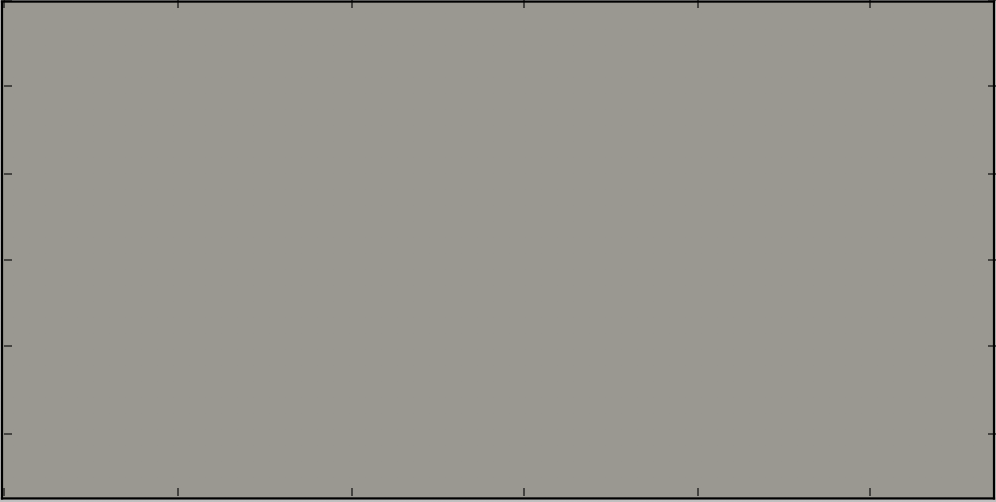
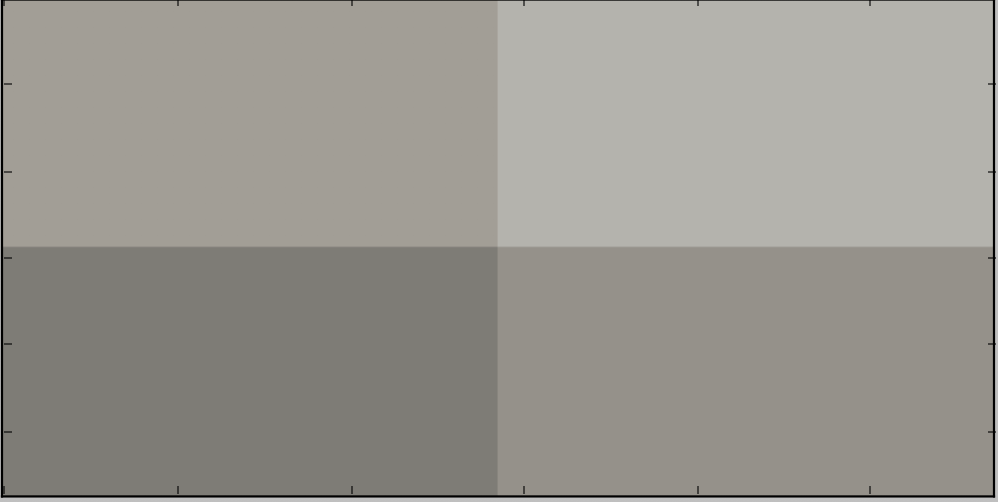
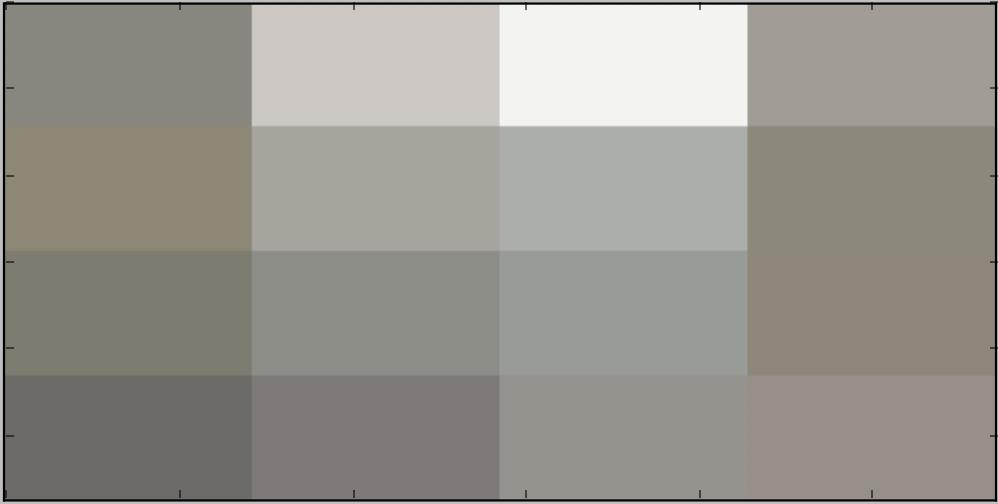
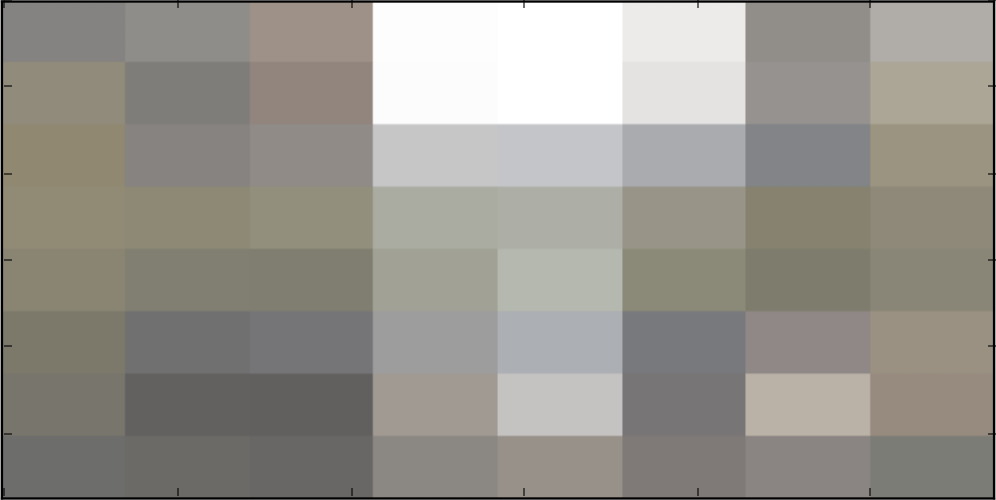
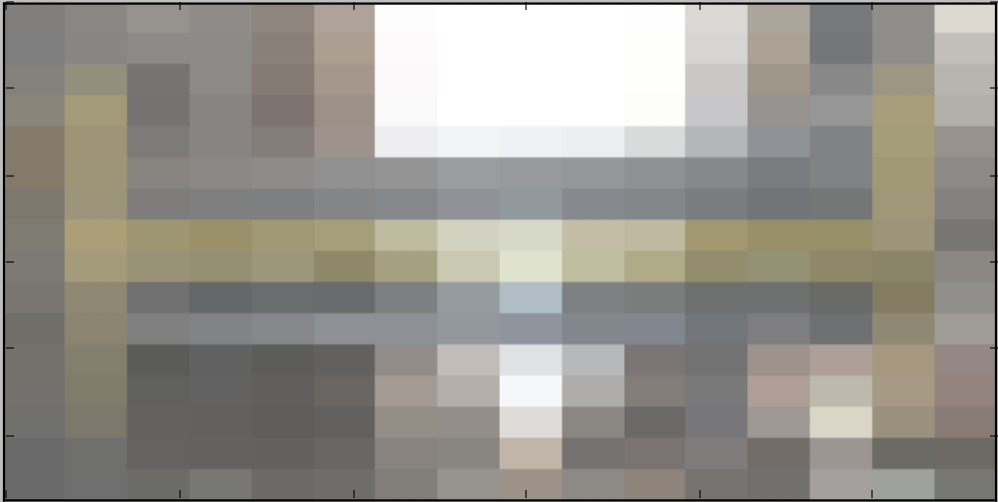
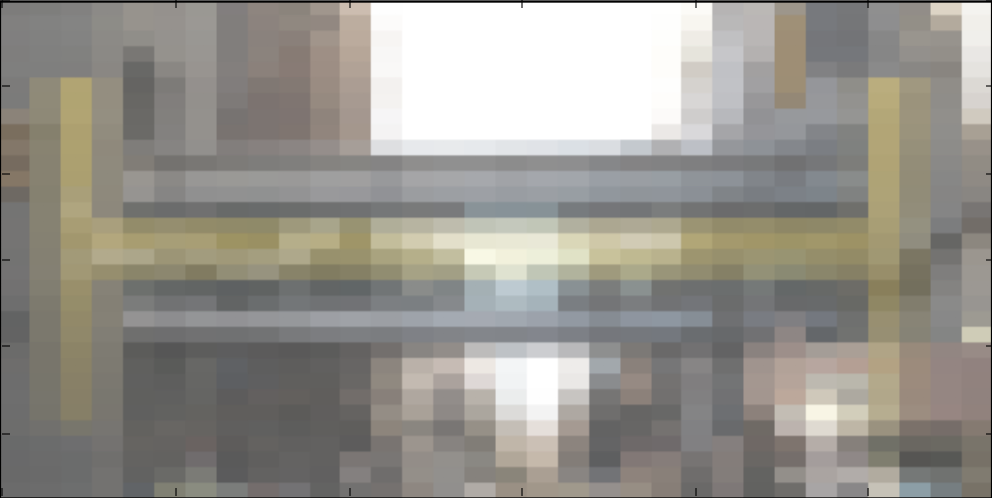
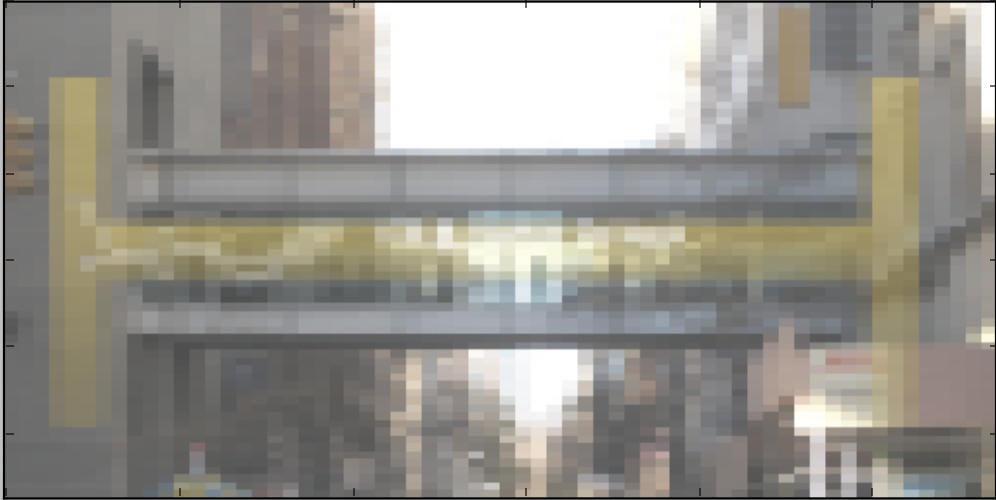
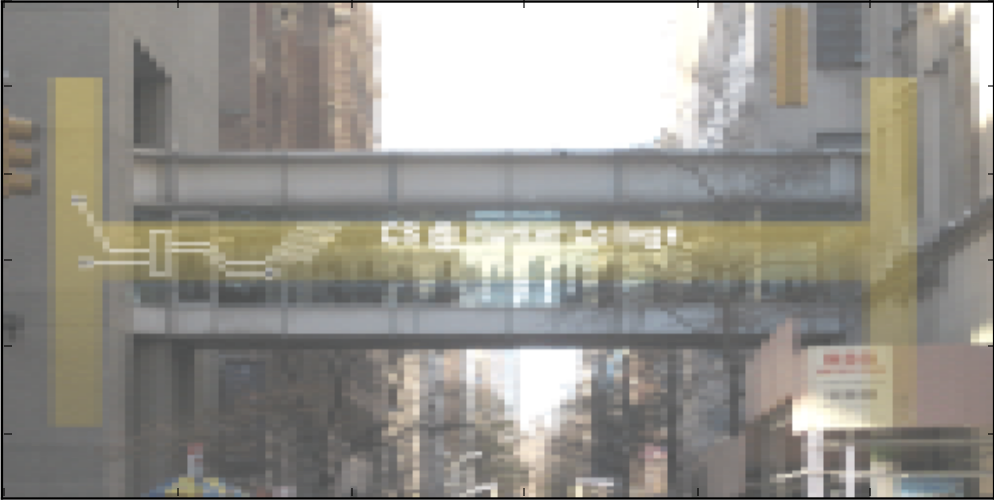
and finally:

A template program, averageImage.py, is available on the CSci 127 repo on github. The grading script does not run the whole program, but instead runs each of your functions separately ('unit tests') to determine correctness. As such, the names of the functions must match exactly the ones listed above (else, the scripts cannot find them).
Hint: See notes from Lecture 8.
- Due Date: 15 April Reading: Chapter 8
Modify the program from Lab 10 that makes a turtle walk 100 times. Each "walk" is 10 steps forward and the turtle can turn 0,1,2,...,359 degrees (chosen randomly) at the beginning of each walk.
A sample run of your program:
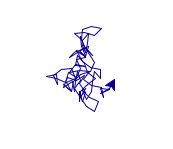
- Due Date: 16 April Reading: Chapter 8
Write a program that asks the user to enter a string. If the user enters an empty string, your program should continue prompting the user for a new string until they enter a non-empty string. Your program should then print out the string entered.
A sample run of your program:
Enter a non-empty string: That was empty. Try again. Enter a non-empty string: That was empty. Try again. Enter a non-empty string: Mihi cura futuri You entered: Mihi cura futuri
Hint: See Lab 10.
- Due Date: 17 April Reading: Ubuntu Terminal Reference Sheet
Write an Unix shell script that does the following:
- Creates a directory, projectFiles.
- Creates 3 additional directories (as subdirectories of projectFiles): source, data, and results.
Hint: See Lab 10.
- Due Date: 29 April Reading: MIPS Wikibooks
Write a simplified machine language program that prints: Hello, World!
See Lab 11 for details on submitting the simplified machine language programs.
Hint: You may find the following table useful:
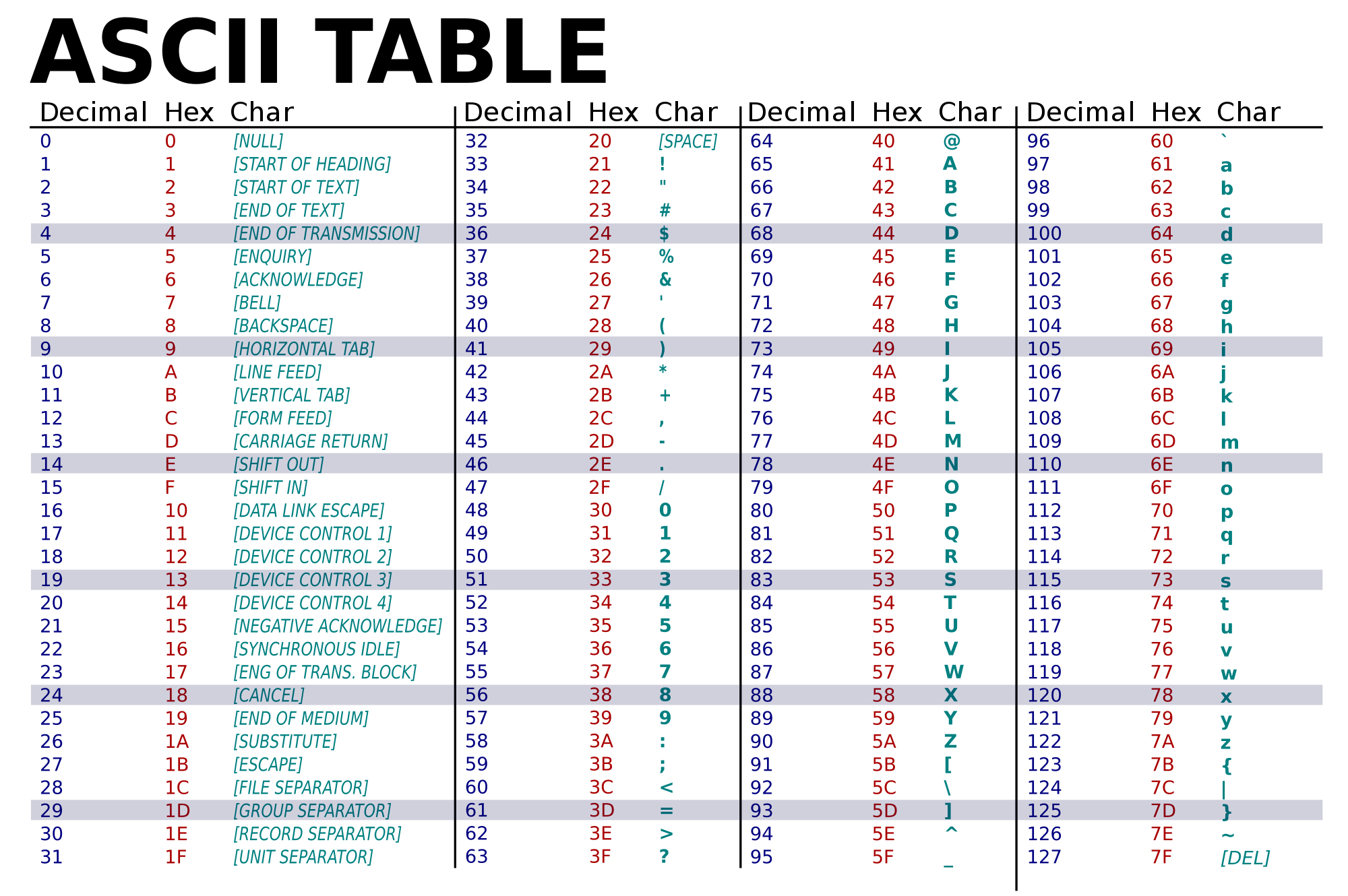
(Image from wikimedia commons)Hint: The grading scripts are matching the phrase exactly, so, you need to include the spacing and punctuation.
- Due Date: 30 April Reading: MIPS Wikibooks
Write a simplified machine language program that has register $s0 loop through the numbers 0, 5, 10, ..., 50.
See Lab 11 for details on submitting the simplified machine language programs.
- Due Date: 1 May Reading: Ubuntu Terminal Reference Sheet
Using Unix shell commands, write a script that counts the number of .py files in current working directory.
Hint: See Lab 11.
- Due Date: 2 May Reading: Cplusplus Tutorial
Write a C++ program that prints "Hello, World!" to the screen.
Hint: See Lab 12 for getting started with C++.
- Due Date: 3 May Reading: Cplusplus Tutorial
Write a C++ program that will print "Mihi cura futuri" 19 times.
The output of your program should be:
Mihi cura futuri Mihi cura futuri Mihi cura futuri Mihi cura futuri Mihi cura futuri Mihi cura futuri Mihi cura futuri Mihi cura futuri Mihi cura futuri Mihi cura futuri Mihi cura futuri Mihi cura futuri Mihi cura futuri Mihi cura futuri Mihi cura futuri Mihi cura futuri Mihi cura futuri Mihi cura futuri Mihi cura futuri
Hint: See Lab 12 for getting started with C++.
- Due Date: 6 May Reading: Cplusplus Tutorial
Write a C++ program that converts kilometers to miles. Your program should prompt the user for the number of kilometers and then print out the number of miles.
A useful formula: miles = 0.621371* kilometers.
See Lab 4 for designing Input-Process-Output programs and Lab 12 for getting started with C++.
- Due Date: 7 May Reading: Cplusplus Tutorial
Write a C++ program program that asks the user for a number and draws a grid of zeros and ones of that height and width using 'character graphics'.
A sample run:
Enter a number: 6 010101 101010 010101 101010 010101 101010
Another sample run:
Enter a number: 3 010 101 010
Hint: if your nested loops have index variables, i and j, then what does: cout << ((i+j)%2) do?
- Due Date: 8 May Reading: Cplusplus Tutorial
Write a C++ program that asks the user for the hour of the day (in 24 hour time), and prints
- "Good Morning" if it is strictly before 12,
- "Good Afternoon" if it is 12 or greater, but strictly before 17, and
- "Good Evening" otherwise.
A sample run:
Enter hour (in 24 hour time): 11 Good Morning
Another sample run:
Enter hour (in 24 hour time): 20 Good Evening
And another run:
Enter hour (in 24 hour time): 15 Good Afternoon
- Due Date: 9 May Reading: Cplusplus Tutorial
Write a C++ program that asks the user for their age, and continue asking until the number entered positive (that is, greater than 0).
A sample run:
Please enter age: -6 Entered a negative number. Please enter age: -50 Entered a negative number. Please enter age: 100 You entered your age as: 100
Hint: Rewrite the Python program from Lab 10 in C++.
- Due Date: 13 May Reading: Cplusplus Tutorial
Write a C++ program that asks the user for the starting amount, and prints out the yearly balance of a savings account, assuming 10% interest, until the amount has doubled.
A sample run:
Please enter the starting amount: 1000 Year 1 1100.00 Year 2 1210.00 Year 3 1331.00 Year 4 1464.10 Year 5 1610.51 Year 6 1771.56 Year 7 1948.72 Year 8 2143.59
Hint: Use an indefinite loop and continue looping while the balance is less than twice the initial amount.
Note: the autograder is expecting each line to begin with "Year " and the corresponding number for the year.
- Due Date: 14 May Reading: Cplusplus Tutorial
Write a C++ program that asks the user for a whole number between -31 and 31 and prints out the number in "two's complement" notation, using the following algorithm:
- Ask the user for a number, n.
- If the number is negative, print a 1 and let x = 32 + n.
- If the number is not negative, print a 0 and let x = n.
- Let b = 16.
- While b > 0.5:
- If x >= b then print 1, otherwise print 0
- Let x be the remainder of dividing x by b.
- Let b be b/2.
- Print a new line ('\n').
A sample run:
Enter a number: 8 001000
Another run:
Enter a number: -1 111111
- Due Date: 21 February Think CS: Chapters 2 & 9
More to come...
